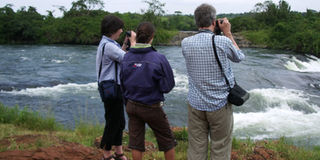Tourism board gets Shs4 billion to market Uganda

Tourists take a picture of River Nile. Uganda Tourism Board has embarked on a campaign to increase tourist arrivals in the country. File photo
What you need to know:
Earnings from tourism currently stand at $1.4 billion (about Shs4 trillion).
Kampala- Uganda is likely to witness increased tourists arrivals if a new marketing strategy hatched by Uganda Tourism Board (UTB) takes off.
According to the UTB chief executive officer, Mr Stephen Asiimwe, they have earmarked $1.5 million (about Shs4.2 billion) through the World Bank’s Competitiveness Enterprise Development Project (CEDP) initiative to cover the campaign.
“We are looking for competent firms which will market our country. These firms must know about tourism attractions and the rich biodiversity that Uganda has,” Mr Asiimwe explained.
He added that the agencies will be Uganda’s representatives in three regions identified mainly as North America and Canada, United Kingdom and Ireland and the German speaking countries of Austria, German and Switzerland.
“We expect the nominated firms to clear the air about Uganda’s status mainly targeting big media companies in these countries and tour operators. They will do a lot of social media campaign about Uganda and attend respective meetings all geared at promoting and marketing Uganda,” Mr Asiimwe added.
Trek East Africa Safaris managing director Geoffrey Baluku welcomed the idea.
He said: “This campaign should not only focus on the regions where Uganda is known, but also exploit areas where Uganda is not known.”
According the tourism board, current tourist arrivals into Uganda have reached 1.4 million as of 2014 records and this is up from 600,000 in 2006.
These numbers have also seen the country’s earnings from tourists arrivals go up to $1.4 billion (about Shs4 trillion) in 2013-2014 up from $600,000 (about Shs1.2 billion) realised in 2006.
Mr Asiimwe, however, said though government investments in tourism have risen from $5,000 to $2 million (about Shs5.7 billion), more funding is still needed.




